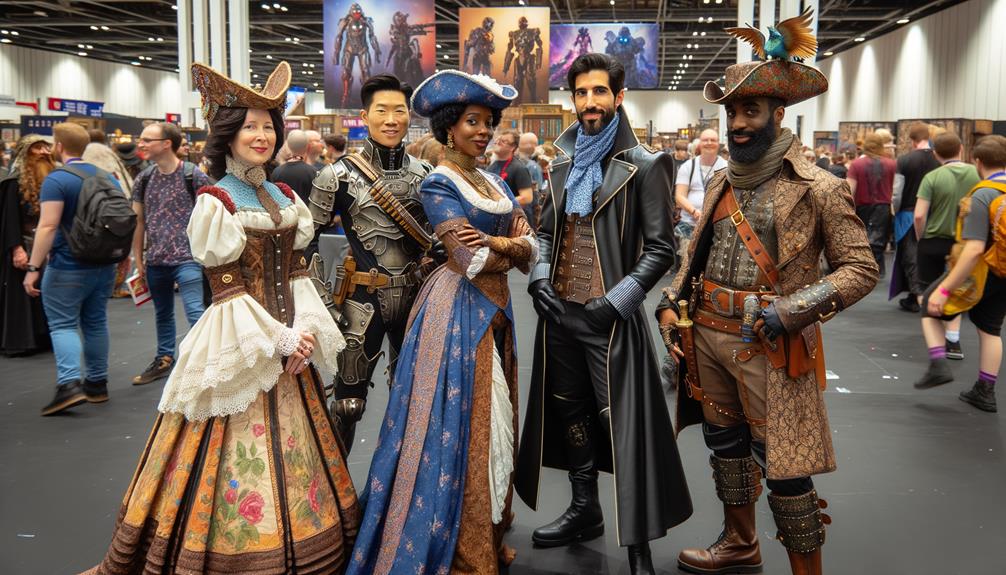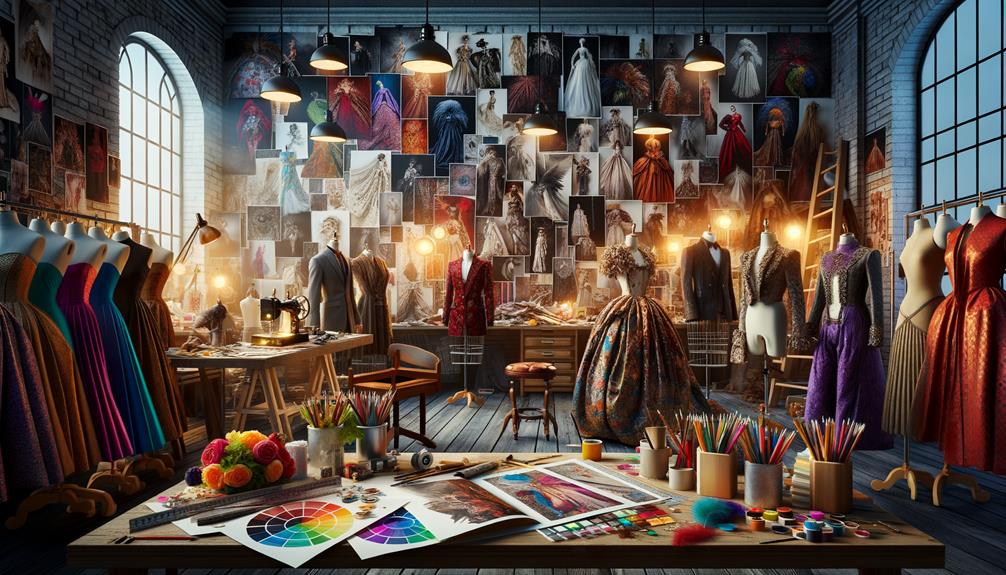Costume design is more than just fabrics and stitching – it's a way to bring a character's essence to life. I see each costume as a subtle narrative tool that reveals a character's inner world. The colors and fabrics I choose can suggest emotions, while the silhouette conveys strength or vulnerability. For example, red can spark passion, blue can whisper calm, and green can nurture growth.
Historical accuracy is crucial for rooting a character in their world and reflecting their social status and cultural nuances. Every tear and embellishment on the costume tells a story, guiding the audience's emotions and deepening the narrative. It's fascinating to see how costume design shapes authenticity and elevates the character's journey. By exploring these elements, we can uncover how they intertwine to enhance the storytelling tapestry.
Historical Context
Reflecting on the history of costume design, it's fascinating to see how this art form has evolved from ancient Greek theater to the visually stunning worlds of modern cinema. Costume has always been a vital element in storytelling, bringing characters and narratives to life.
In ancient Greek theater, costumes were more than just attire – they were symbols that conveyed the essence of the gods, heroes, and commoners depicted on stage. During the Middle Ages, what people could wear was dictated by sumptuary laws, underscoring the importance of costume in signaling social status and identity. Attire could command respect or subjugation, acting as a powerful, silent language of power.
The Renaissance period saw an explosion of opulence in costume design. Nobles adorned themselves in elaborate garments that spoke volumes about their wealth and status, turning costume into a visual display of power and privilege. By the 19th century, the craft became more professionalized, with dedicated costume departments in theaters and operas, elevating the art form to new heights.
Symbolism and Meaning
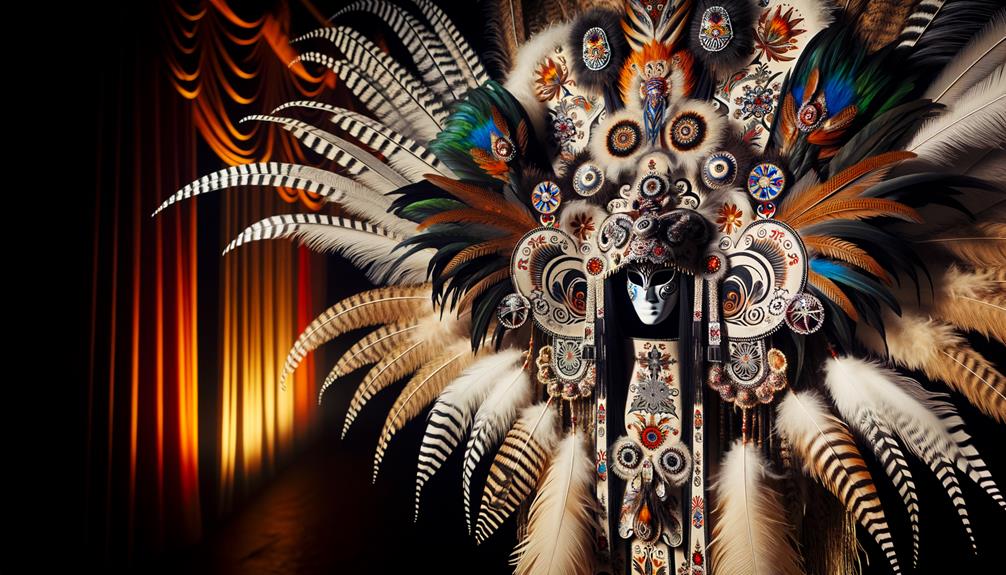
When I think about costume design, I'm struck by how the choice of colors and fabrics can subtly shape our perception of a character's inner life. Each decision the designer makes, from the cut of a garment to the smallest accessory, weaves a narrative that speaks volumes about identity and emotion. Reflecting on historical context, it's fascinating to see how these elements combine to create a rich tapestry of meaning, grounding characters in their time and place.
The cut of a jacket, the drape of a dress – these details can convey a wealth of information. A bold, angular silhouette might suggest a character's confidence and determination, while soft, flowing lines could evoke a sense of vulnerability or grace. And the colors? They're like visual shorthand, evoking certain moods or associations in the audience's mind.
It's a delicate balancing act, but when costume design hits the mark, it can elevate a performance, making the characters feel more authentic and fully realized. It's a powerful storytelling tool, one that deserves close attention from anyone interested in the craft of filmmaking or theater.
Colors and Emotions
Colors play a powerful role in how we perceive characters on screen. Costume designers strategically use color to evoke specific emotions and shape our understanding of a character.
When a character wears red, it instantly suggests passion, power, or even danger. Blue costumes, on the other hand, convey a sense of calm trust and stability, making the character feel more approachable.
Yellow garments bring a cheerful optimism that brightens the scene and lifts our spirits. Green signifies growth and harmony, grounding the character in a natural, holistic way.
Black costumes imbue a character with mystery or an air of mourning, while white speaks of purity and fresh beginnings – a blank slate of potential.
These color choices are not merely aesthetic; they hold deeper emotional resonance. Costume designers meticulously select colors to convey a character's essence, social standing, and the overall mood of the narrative. This nuanced approach profoundly shapes our viewing experience, subtly guiding our emotional journey through the story.
Historical Context Influence
Colors have a powerful ability to evoke emotions, but the historical context of costumes adds even deeper layers of meaning that enrich our understanding of characters and their worlds. As a costume designer, I must consider the intricate web of social cues, power dynamics, and cultural touchstones that define each era. This meticulous process involves delving into the sartorial customs and societal norms of the time to ensure authenticity.
Historical references are not just aesthetic choices; they carry profound implications:
- Social Status: The choice of fabric and garment style can instantly convey a character's rank and wealth.
- Gender Roles: Distinctive attire reflects the gender expectations and limitations imposed by the era.
- Political Affiliations: Colors and symbols in costumes can subtly indicate a character's political stance or allegiance.
Incorporating these elements requires a balance between historical accuracy and creative interpretation. It's not merely about replicating period attire but about using it to enhance narrative depth. By understanding the cultural significance of each costume, I can craft visuals that resonate with the audience on a deeper level, ultimately making the story more compelling and immersive.
Character Identity Expression
Costume design is more than just fabric and fashion – it's a meticulous craft that brings a character's identity to life. When designing for a character, I focus on who they are at their core. The careful selection of fabric, color, and silhouette can convey a character's personality, social status, values, and emotional state.
The evolution of a character's wardrobe can mirror their internal journey. For instance, a character starting in muted, restrictive garments might shift to vibrant, flowing attire as they gain confidence and freedom. This transformation connects the audience to the character's growth and struggles.
Motifs, patterns, and embellishments are narrative tools, not just decorative elements. A recurring pattern might hint at a hidden past, while specific embellishments can signify status or allegiance. These elements create a tapestry of meaning that deepens the audience's understanding and emotional connection.
Ultimately, costume design shapes a character's credibility and authenticity, weaving a rich, visual narrative that speaks volumes about who they are and what they represent.
Character Development
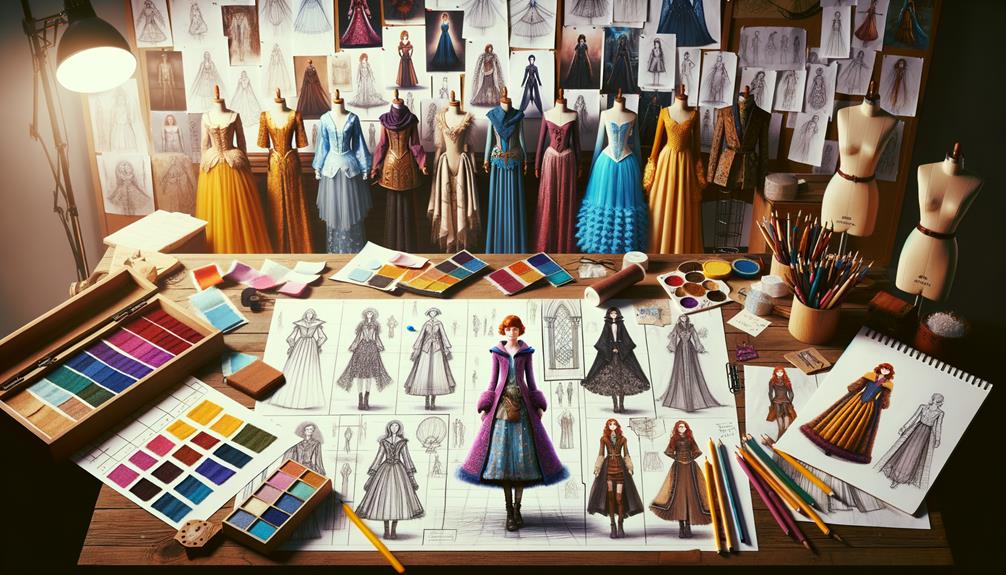
When it comes to character development, costume choices can profoundly shape how the audience perceives the character. The symbolism and color palette used in the costume can subtly reveal layers of the character's narrative, while historical accuracy grounds the character in a believable context. It's fascinating to see how these visual cues can make a character's journey so visceral and emotionally resonant for the viewer.
Influencing Audience Perception
A single costume can reveal a lot about a character's background, motivations, and evolution throughout the story. When designing a costume, I pay attention to every detail, knowing that each choice will influence how the audience perceives the character's emotional journey. A carefully selected outfit can uncover inner conflicts, desires, and personal growth, making the character's arc more tangible.
Consider the following elements that can subtly guide audience perception:
- Texture: Rough, worn fabrics can suggest a difficult life, while smooth, lavish materials might indicate wealth or vanity.
- Fit: A tight, restrictive outfit can symbolize a character feeling trapped, whereas loose, flowing garments might evoke freedom or carefree spirit.
- Accessories: Items like jewelry, hats, or scarves can hint at cultural background, personal significance, or even hidden aspects of a character's personality.
These elements work together to shape how viewers connect with and understand the character. It's not just about aesthetics; it's about creating a visual language that conveys the unspoken. By meticulously crafting these details, I aim to guide the audience through the character's emotional journey, making their story resonate and memorable.
Symbolism and Color Choices
Every color and symbol in a costume is carefully selected to reflect the multifaceted nature of a character's development. The palette and motifs of a costume do more than just clothe the character; they breathe life into their very essence. For instance, the use of red can symbolize passion or danger, while blue can signify calm or melancholy. These color choices are not arbitrary; they carry psychological undertones that resonate with the audience.
| Color | Symbolism |
|---|---|
| Red | Passion, Danger |
| Blue | Calm, Melancholy |
| Green | Growth, Envy |
The subtleties of these choices can transform a mere outfit into a storytelling device. When designing, I often consider how a hue or pattern might reveal hidden facets of a character's journey. A villain draped in black not only signifies malevolence but also hints at complexity and depth. Symbolism in costume design is like a painter's brushstroke, evoking emotions and foreshadowing narrative twists. A simple color can encapsulate an entire character arc, making the invisible visible. Through these choices, we craft characters that are not just seen, but felt.
Historical Accuracy Impact
Historical costumes are a tangible link to the past, grounding characters in their specific era and enhancing the authenticity of their narrative. When considering the impact of historical accuracy in costume design, I realize it's an integral part of character development. Designers must carefully research periods, cultures, and social norms to create authentic sartorial representations that drive a character's story. This attention to detail does more than just dress a character; it breathes life into their backstory, sociopolitical status, and psychological profile.
Consider the following aspects:
- Backstory: Accurate costumes hint at a character's past, allowing audiences to infer their history without explicit exposition.
- Sociopolitical Status: Clothing can signify a character's social rank or political alignment, adding layers to their personality and motivations.
- Psychological Profile: The wear and tear of garments can reflect a character's mental state and emotional journey throughout the narrative.
Mismatching a character's costume to their era can undermine narrative believability and audience immersion. On the other hand, costume choices that reflect a character's evolution can visually chart their transformation, enhancing the overall cinematic experience. It's clear that historical accuracy in costume design isn't just about aesthetics; it's about credibility and depth.
Color Psychology
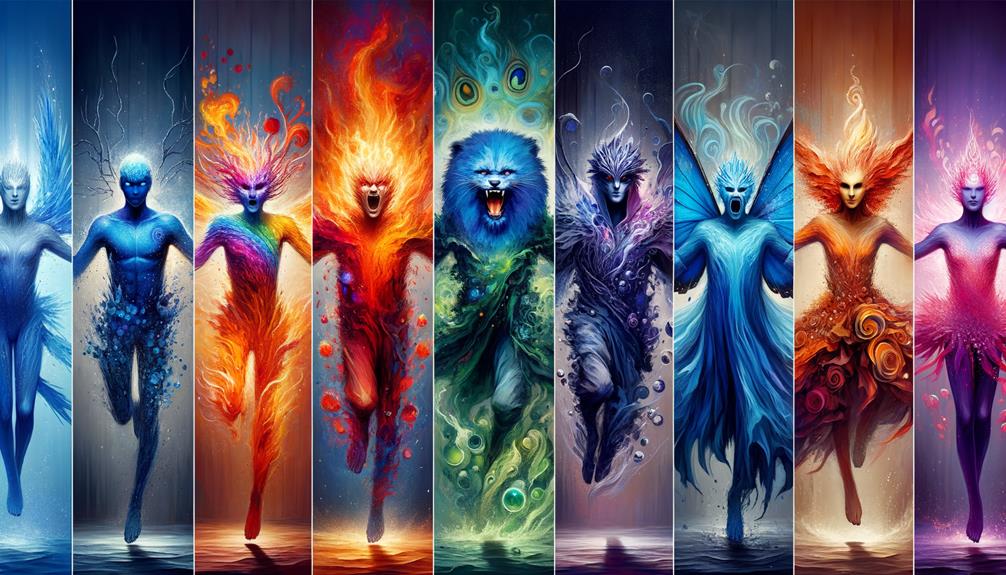
I've always been fascinated by how colors in costume design can subtly yet powerfully influence our emotions and perceptions of a character. When we first see a character, the colors they wear can speak volumes before they even say a word. As I create costumes, I carefully choose hues that reflect the underlying essence of the character.
Red, for instance, can evoke passion, danger, or power, immediately signaling intensity. Imagine a villain draped in crimson; the color itself becomes a harbinger of peril. Blue, in stark contrast, exudes calmness and intelligence, often cloaking the wise and the introspective.
Yellow brightens the screen with its cheerful and optimistic energy. Conversely, black carries an air of sophistication, mystery, and occasionally, death. It's the color of the enigmatic, the sophisticated, and the mournful.
Green stands for growth, renewal, and balance, grounding a character in nature and vitality, while purple, the hue of royalty, luxury, and spirituality, bestows a sense of grandeur. The strategic use of these colors can profoundly shape a character's personality and the film's overall mood, making the palette as essential as the script itself.
Cultural Influences
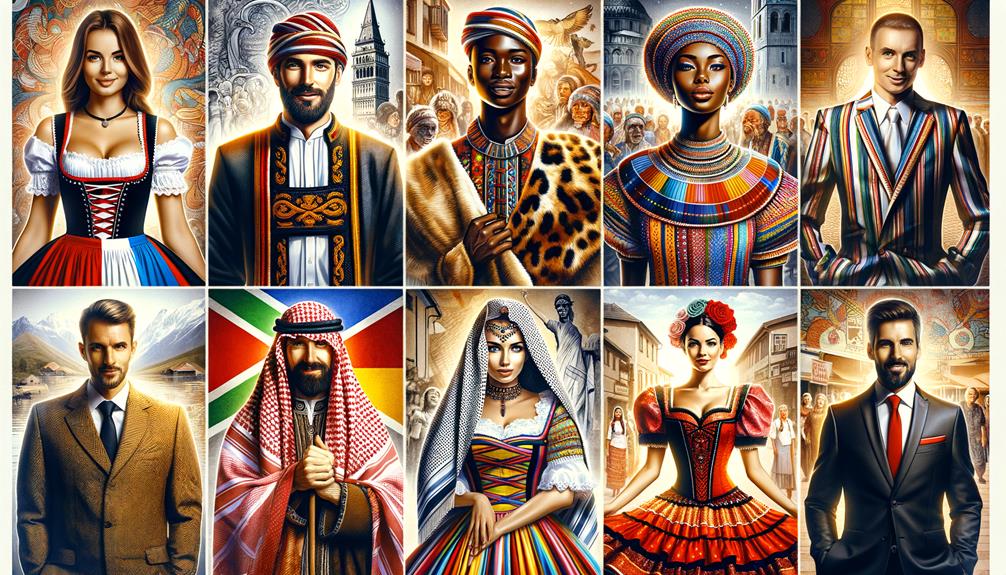
When designing costumes, it's crucial to study the cultural background, as it can profoundly shape the characters' identities and the narrative's authenticity. Each aspect of costume design carries the weight of cultural influences, whether it's through fabric, color, or accessories. It's not just about looks; it's about embedding history, values, and social norms into the very threads of the garments.
For instance, the choice of fabric can speak volumes:
- Silk versus cotton reflects social status and regional significance.
- Patterns and motifs can indicate tribal affiliations or historical periods.
- Accessories and adornments provide insights into character roles and societal hierarchies.
Emotional Impact
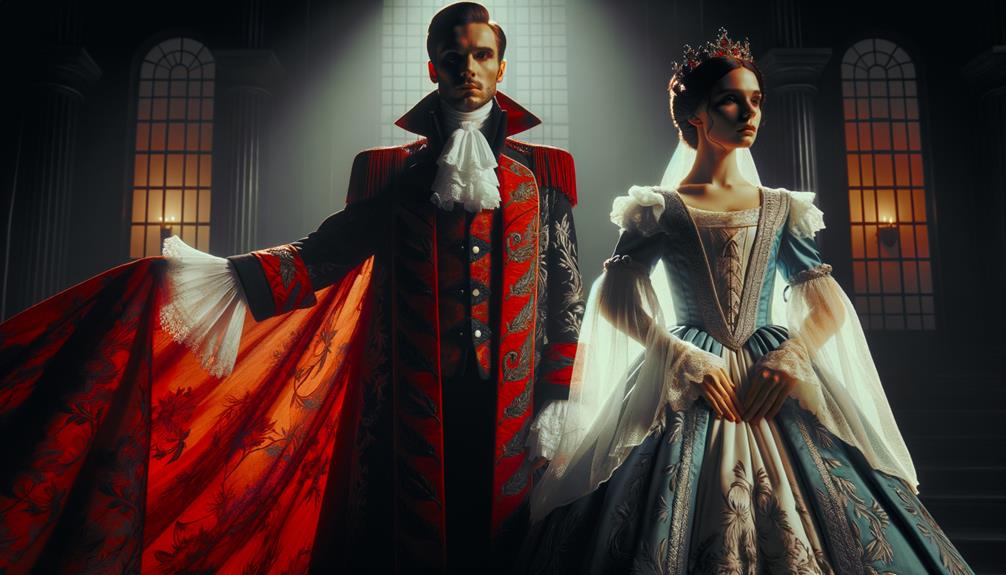
Costume design isn't just about fabrics and stitches; it's about creating an emotional journey that resonates with the audience. The choices of color, texture, and silhouette are essential in communicating a character's inner world. For instance, a character struggling with mental illness could have their attire subtly reflect their turmoil through fractured patterns or muted tones, enhancing the audience's understanding without saying a word.
The emotional impact of costume design goes beyond aesthetics. Carefully crafted costumes can heighten drama, suspense, or comedy, immersing viewers in the narrative. The act of dressing and undressing an actor is symbolic, marking the character's transformations and emotional arcs. This conscious manipulation of attire allows the audience to feel each shift and revelation more profoundly.
Collaboration with actors is crucial. A costume must empower them to fully embody their roles, transforming mere fabric into an extension of their emotional state. When done right, costume design becomes a silent but powerful storyteller, guiding the audience through a labyrinth of emotions, making each scene resonate more deeply. It's an art that transcends visual appeal, touching the very core of human experience.
Frequently Asked Questions
What Is the Psychology Behind Costume Design?
When I work on costume design, I'm not just creating clothes; I'm crafting a character's inner world. Every fabric choice, color, and accessory embodies their personality and emotions, shaping how the audience perceives and connects with them. It's a transformative storytelling process that brings characters to life.
I choose materials, hues, and accessories that reflect the character's psyche and experiences. These design elements become an extension of who they are, conveying their moods, values, and history without relying on dialogue alone. It's a visual language that speaks volumes about the person behind the costume.
As a costume designer, I'm not merely dressing actors – I'm revealing the characters' souls. It's a responsibility I take seriously, as these sartorial choices can make or break an audience's emotional investment in the story. The right costume can make a character instantly relatable or enigmatic, drawing viewers into their world.
Ultimately, costume design is about more than just fashion – it's about capturing the essence of a character and using that to enhance the overall narrative. It's a craft that requires empathy, creativity, and a deep understanding of human nature. When done well, it can elevate the entire storytelling experience.
What Is the Psychology of Wearing Costumes?
When I wore a superhero costume, I felt powerful, like I was embodying courage and strength. Donning costumes allows us to explore new identities, boosting our confidence and self-discovery. It's a transformative experience, encouraging personal growth and emotional expression in ways we may have never imagined.
What Is the Psychology of Clothing Fashion?
When I choose my clothes, I'm expressing who I am, how I feel, and what I aspire to. Fashion is a powerful way for me to shape how I see myself and how others perceive me. It can profoundly influence my confidence and mental state.
Clothing is more than just a practical necessity – it's a reflection of my identity. The outfits I select send a message about my personality, mood, and values. Wearing certain styles or brands can make me feel more assured or help me project an image I want to convey to the world.
At the same time, fashion isn't just about me. The way I dress also shapes how others interact with me. People often make quick judgments based on appearance, so my clothing choices can impact how they respond to me and the opportunities they see me as deserving.
What Is the Psychology of Cosplaying?
Cosplaying allows me to step away from my everyday self, which can boost my self-esteem and emotional well-being. Crafting costumes is a therapeutic process that helps me cope with social anxiety. It also enhances my problem-solving skills and imagination, and offers a creative, supportive community to be a part of.
Conclusion
Reflecting on the psychology of costume design, I'm reminded of Heath Ledger's Joker. His disheveled suit and smeared makeup weren't just choices; they conveyed a sense of chaos and madness, enhancing his menacing presence. Costumes have the power to shape our perceptions, silently communicating volumes about a character. They're not just fabric, but storytellers, weaving threads of history, symbolism, and emotion. As I explore this further, I realize how profoundly costumes can impact our understanding of characters, connecting us on an almost subconscious level.



